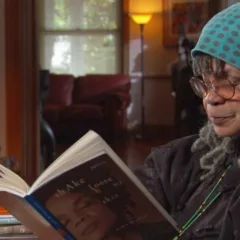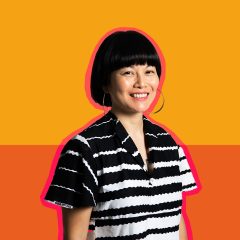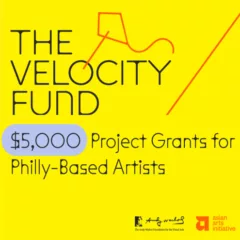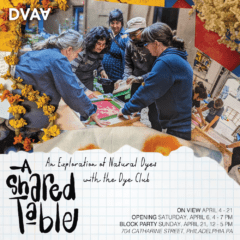I got lucky Friday and caught the two Taiwanese artists installing out at the Schuylkill Center for Environmental Education for the show Go Green: New Environmental Art from Taiwan.
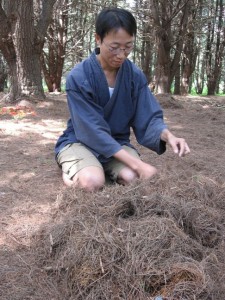
As I wended my way along the paths, passing by intriguing sculptures for still another environmental art exhibit, I came upon Tim Allen, resting on a bench. Allen is the husband of Jane Ingram Allen, the curator of Go Green.
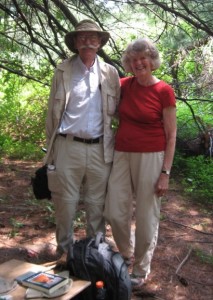
Tim and I talked as we walked along the path toward the working artists. We talked about the different attitudes toward time in Taiwan, where productivity is sacrificed for social relations, he said. And we talked about the American passion for possessions. He and Jane have been living more sparely in Taiwan for six years, staying on there after her Fulbright for studying paper-making techniques.
We found artist Chao-chang Lee on his hands and knees in a grove of pine trees, carefully sifting through the carpet of dry needles on the forest floor for broken branches. “I am sick,” he said, and the art work was calming for him. I saw no sign of sickness, and perhaps something got lost in translation.
Lee was creating an outline drawing on the ground of an enormous, seated Buddha–maybe 25 feet tall and equally wide at the knees. “It started at 300 centimeters [about 10 feet] but now it’s huge!” The branches create the perimeter. “Everything is Buddha,” said Lee.
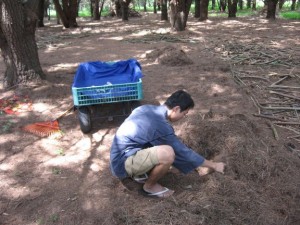
The site-specific piece Table of Buddha is a shrine as well as a retreat, a place to offer food to the Buddha before consuming it. Lee said that houses in Taiwan, there is a room for Buddha, and on his table every day, the residents array flowers and food, then eat the food at night. And that’s the plan for the Saturday (Aug. 7) reception at SCEE–welcoming people to bring food for the Buddha and then sharing in it. When I sat down Indian-style on the forest floor with Lee, who was kneeling, pointed out I was sitting in the same style as the Buddha!
Chao-chang means sunrise house, and like the day, the artist’s work is transitory. “Inspiration can’t hold forever,” he said. This show is also transitory, open until August 20 in Philadelphia, Then moving on for a month in Eureka, California and a couple of weeks at the University of North Carolina. The show has already been at the Queens Botanical Garden in Flushing, NY.
Ingram Allen said that until recently Taiwanese art focused largely on the issue of Taiwanese identity–what it means to be Chinese and not Chinese. So dominant was this issue, as well as the culture’s commitment to technology, that that environmental art is a recent development there.
I asked Lee about his studio. He lives in a very small house, taking care of his parents, who are getting old. He had no real studio. Then he said, “I have different houses in the earth.” And there he was, sitting in his newest one at SCEE.
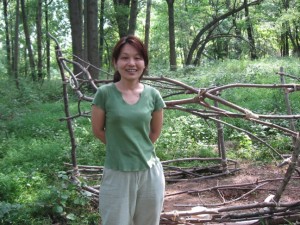
Ingram Allen took me farther along the path to meet artist Ping-yu Pan, a professor in Taipei, who was lashing together branches to create a boat-shaped fence around a sapling. She said she was protecting the sapling from the ravenous deer. “[The boat] is the Ark for Plants, inspired by Noah’s ark,” she said. She mused a bit about the similarities in Asian and Western myths and Joseph Campbell’s ideas of archetypal myths. “We also have a flood.”
“Making art work is not just about yourself,” she said, adding that she hoped the work would maybe give someone else a new idea, or comfort people and give them a happy day.
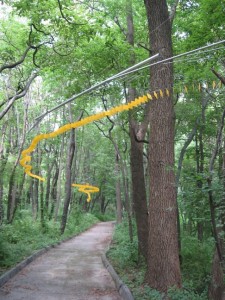
These next two weeks are the only opportunity to see not just the two Asian installations, which exude a sense of stillness and place, but also six sculptures in the “elemental energy: art powered by nature” show. The works are gizmos that harness natural forces. The yellow plastic paddles of Yellow Zinger, By Tim Prentice (CT), respond to the wind, creating a snaky drawing that wiggles with the wind. And Joe Chirchirillo (VT) has made a sort of tin-roofed shed onto which water splashes. I didn’t see or hear the water splashing and I’m unclear on how its is harnessing a natural force, but I love the Rube Goldbergian, jury-rigged frontier building that is a nostalgic shout-out to American ingenuity and survival. Other works include a couple of solar-powered sound pieces, one by Jason Krugman and Christian Cerrito (NY) and one by Patrick Marold (CO); and a couple of other kinetic sculptures, one by Mark Malmberg (CA) that’s solar powered, and one by Moto Ohtake (CA), that’s wind-powered.
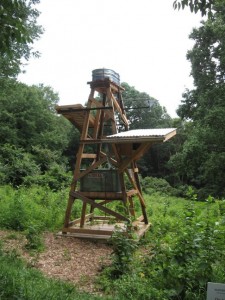
A second part of Go Green show is opening tomorrow at the Asian Arts Initiative. The event will include a discussion with the two Taiwanese artists, the curator and Mary Salvante, who is the advising director of SCEE’s environmental art program. The AAI exhibit documents other Taiwanese environmental art installations as well. Go Green, in all its permutations and venues, includes the work of 16 artists and marks an important new stream of art from Taiwan.
Go Green, Fri., Aug. 6, opening reception and discussion at the AAI. 5:30-7:30 p.m.
Go Green, Saturday, August 7, 3 p.m. – 5 p.m., SCEE. Guided tours of the exhibit’s outdoor installations; Chao-chang Lee and Pin-yu Pan will discuss their works.
elemental energy: art powered by nature, May 1 – Sept. 26 at SCEE.


